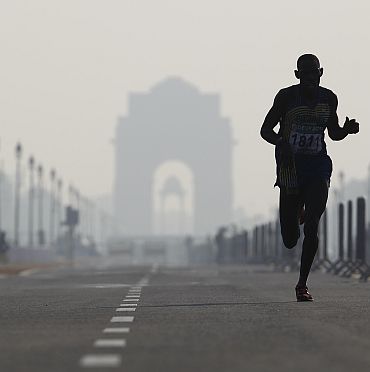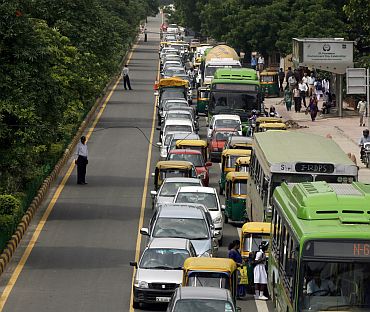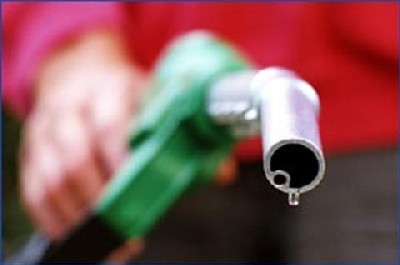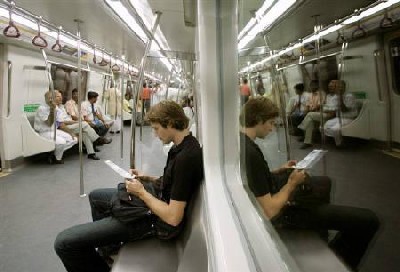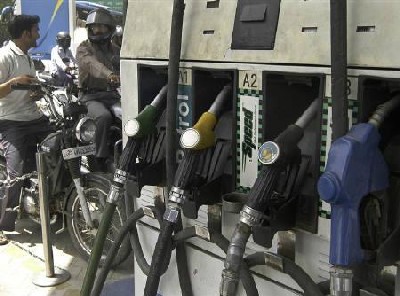 | « Back to article | Print this article |
Delhi bucks national trend, consumes less petrol
It's a capital shock. Delhi, which has more cars than the three other metro cities put together, is seeing a drop in petrol consumption. This is against the national growth trend. The consumption of the fuel declined by a startling nine per cent in November, while diesel grew by 19 per cent. CNG sales have also grown by around 15 per cent.
In the April-November period of the current financial year, petrol consumption in Delhi registered a drop of 1.34 per cent. National consumption, on the other hand, has been growing rapidly.
In the April-October period this year, the national petrol consumption grew 4.8 per cent -- lower when seen against last year's double-digit growth, but still healthy.
Click NEXT to read more...
Delhi bucks national trend, consumes less petrol
The national consumption data comes with a lag of over two weeks, so the numbers for November are not yet available. Delhi's diesel consumption grew by an impressive 22.4 per cent in the April-November period, way above the national growth of 5.9 per cent in the April-October period.
Delhiites could have cut down on petrol consumption as reaction to high prices and shifted to diesel and CNG vehicles, besides using the mass rapid transit system. Nishi Goel, vice-president of the Delhi Petrol Dealers Association, said the declining trend in petrol had been witnessed after more than a decade.
"When Supreme Court had, in 1998, ordered conversion of all auto rickshaws to CNG, a decline in consumption had taken place. So, this drop is happening for the first time in more than a decade," he said.
Click NEXT to read more...
Delhi bucks national trend, consumes less petrol
Petrol prices have moved up by 37 per cent, to Rs 65.64 per litre, since decontrol in Delhi. During this period, diesel prices, which are still regulated, have risen just 7.37 per cent to Rs 40.91 per litre.
Compared to petrol, CNG offers 65 per cent savings at current prices. According to automobile industry data, sale of diesel passenger vehicles has grown by around 22 per cent this year, compared to a decline of 14 per cent in sales of petrol vehicles.
Car owners are becoming sensitive to conservation efforts. Those who have an option to park their cars at metro stations and board metro trains to their destinations are increasingly doing so. Metro parking lots are almost full during office hours on weekdays.
Click NEXT to read more...
Delhi bucks national trend, consumes less petrol
With the addition of new lines at regular intervals, Metro ridership numbers have also risen sharply. Employees of BPOs in Gurgaon are being incentivised for taking the Metro at least on one side of their journey. Goel also attributes the fall in petrol consumption to the expanding metro coverage and growth in CNG outlets.
Delhi Metro claims to have removed more than 91,000 vehicles from Delhi roads. "With the construction and operation of Delhi Metro, the Metro complements other modes of transport and partially replaces trips made by conventional or traditional means of transport," it says.
If not for the Metro, the 1.9 million people who use it daily would have travelled by cars, buses or motorbikes.
Click NEXT to read more...
Delhi bucks national trend, consumes less petrol
According to the oil ministry's Petroleum Products Planning and Analysis Cell, shifts in the share of petrol, diesel and CNG in the total auto fuel sales can indicate a change in customers' choice of one fuel over the other.
This can happen on account of three factors. First, the cheaper purchase price of a particular fuel-driven car compared to the other; second, one fuel giving higher mileage than the other; and third, the price of one fuel being lower than the other.
A combination of these three factors is perceived to lead to a discernible change in the share of a particular auto fuel in the total auto fuel sale in the country.
